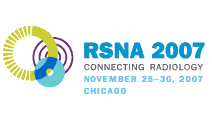
Abstract Archives of the RSNA, 2007
Madelyn Stazzone MD, Presenter: Nothing to Disclose
Parinaz Massoumzadeh PhD, Abstract Co-Author: Nothing to Disclose
Fred William Prior PhD, Abstract Co-Author: Research collaboration, Eastman Kodak Company
Research partner, Merge Healthcare
Research collabortation, Siemens AG
Bruce R. Whiting PhD, Abstract Co-Author: Nothing to Disclose
Three-dimensional imaging is limited in MR. The Rapid Interleave Overlap Technique (RIOT, patent pending) involves the interleave and overlap of multiple series of any standard non-3D sequence into one composite series which can then be used to yield multi-planar and 3D reconstructions. The purpose of this study was to compare RIOT to a standard 3D sequence by measuring signal (SNR), contrast (CNR) and resolution in both.
A phantom was fabricated by the authors from a plastic sphere surrounded by uniform gel in a plastic container. A RIOT True-FISP acquisition of the phantom (compiled of 8 interleaved and overlapped series) was compared to standard 3D True-FISP acquisitions. All three acquisitions had identical fields of view, slice thicknesses, base resolution and phase resolution. The 3D sequences had isotropic voxels of 1mm x 1mm x 1mm, while each of the series compiling RIOT had voxel sizes of 1mm x 1mm x 4mm (anisotropic). Images were loaded onto 3D software and multiplanar reconstructions performed in the sagittal and coronal planes. Analysis of signal intensity within the sphere and within the gel was utilized to yield SNR and CNR in the plane of acquisition (transverse) as well in the sagittal and coronal planes. Resolution was measured by obtaining full width half max of surface spread function. In addition, RIOT experiments were repeated using standard T1W and T2W sequences.
In comparison with the 3D True-FISP sequence, the RIOT acquisition was faster. The resolution with RIOT was less than with standard 3D sequences. However, the signal intensity and contrast was higher with RIOT. In addition, higher resolution could be obtained by applying RIOT to standard T1W sequnces. Ring-down artifacts were seen with all 3D data sets but were absent with RIOT acquisitions.
Given higher SNR and CNR ratios, MPR and 3D reconstructions with RIOT can be a useful alternative to standard 3D sequences, especially given the ability to apply RIOT to sequences with higher resolution.
RIOT will allow MPR and 3D imaging utilizing any standard non-3D sequence, allowing the imager to yield reconstructions using the sequence best suited to demonstrate the pathology.
Stazzone, M,
Massoumzadeh, P,
Prior, F,
Whiting, B,
Comparison of Non-3D True-FISP Images Acquired Using Rapid Interleave Overlap Technique (RIOT) with Standard 3D True-FISP Sequences: Is There Measurable Improvement in Image Quality?. Radiological Society of North America 2007 Scientific Assembly and Annual Meeting, November 25 - November 30, 2007 ,Chicago IL.
http://archive.rsna.org/2007/5012274.html

